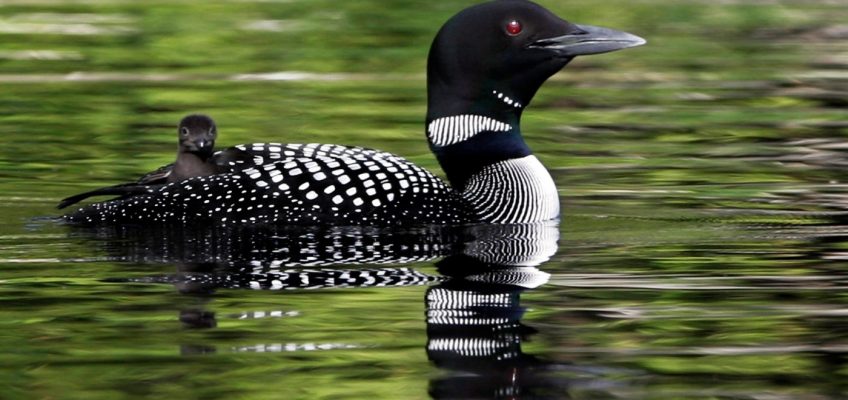RHINELANDER, Wis. — A cascading series of environmental factors pushed by climate change are causing a decline in northern Wisconsin’s loon population and may be limiting loon numbers in Minnesota as well.
Loon researcher Walter Piper holds an adult loon that’s part of a long-term study of what’s causing a decline in loons in northern Wisconsin, especially loon chicks. New data shows the problem appears spurred by reduced water clarity from increasingly frequent heavy rains. (Courtesy of Allison Piper)
That’s the finding of research published in the recent edition of the journal Ecology and conducted on lakes in northeastern Wisconsin. Researchers already knew there has been a 22% decline in loon numbers over the past 27 years in the study area, and now they say the problem is driven by declining water clarity.
That declining water clarity is caused by more runoff and erosion on land, a rush of dissolved organic matter into the lakes, caused by much heavier summer rain events fueled by climate change, said Walter Piper, lead researcher on the long-term project and a professor of biology at Chapman University in California.
Adult loons are finding it harder to find fish to feed their chicks, the study concludes, and the population of young non-breeding loons, which scientists call “floaters,” is down 46% since the study began. Meanwhile, chick weight has declined by 11%, a sign they aren’t getting enough to eat.
“Loss of mass by chicks — which shows up as emaciated chicks that often fail to fledge — appears to be a major driver of the well-documented decline in survival rates of young loons in Wisconsin recently and overall population decline in the region,” researchers concluded. While other studies have shown that loons prefer clear water, this is believed to be the first study to directly link declining water quality and declining loons.
July water clarity decreased by nearly 0.6 meters in the lakes studied from 1995 to 2021. July is the critical month for newly hatched loon chicks to survive toward adulthood, Piper said.
Piper has been studying loons in the project area, around Rhinelander, for 31 years and previously documented declining loon numbers there, especially fewer chicks surviving to make the flight south their first fall. Those findings were published in a 2020 edition of the Condor, the journal of the American Ornithological Society.
But it’s only been in recent years that Piper confirmed the disturbing trend of reduced water quality in July. Loons, which depend on their sight to find and catch fish for food, often pick the clearest lakes to nest on because they can see their prey underwater. Other researchers in the project from Rensselaer Polytechnic Institute in New York used decades of satellite imagery to help track water clarity in the loon lakes studied.
“The hidden nature of the Wisconsin decline points out that floater populations can mask major drops in breeding populations and throws into question population trends in other loon populations, whose floater populations are largely unknown,” researchers wrote.
Piper began expanding his study to include north-central Minnesota lakes in 2021. There are now about 250 Minnesota loons banded and part of the study along with 400 in Wisconsin.
A Common Loon chick hitches a ride on its mother’s back while her mate looks for food on Maranacook Lake, in Winthrop, Maine, Tuesday, July 20, 2021.A cascading series of environmental factors pushed by climate change are causing a decline in northern Wisconsin’s loon population and may be limiting loon numbers in Minnesota as well. That’s the finding of research published in the recent edition of the journal Ecology and conducted on lakes in northeastern Wisconsin.. (AP Photo/Chris O’Meara, File)
“I have been color-marking and studying the behavior and ecology of common loons in northern Wisconsin since 1993. Four years ago, I sensed a decline was afoot in my Wisconsin study population, and this fear was confirmed when I looked at my data,” Piper noted. ”This decline was part of what inspired me to establish a second marked study population of loons in Crow Wing County, Minnesota. We now have about two-thirds of the adult breeders banded in the new Minnesota study area, which includes part of Cass County as well.”
“I’m worried we’re going to see the same problem in Minnesota, but we don’t have enough data yet,” he added, noting state researchers already have seen some decline in loon chicks in Minnesota.
While Piper said other issues are problems for loons — eagles, nest predators like raccoons and lead poisoning — but none have the widespread impact of water clarity declines. He said controlling shoreline runoff along lakes might help curb the issue, as could reducing fertilizers that may be spurring algal blooms and adding to the water clarity problem.
“This is all grim news, I know. But I think we need to get the word out about it,’’ Piper said. “If we narrow down the cause of the loon decline even more, we might take steps to fix the problem. Although, admittedly, we will not fix climate change overnight.”
Related Articles
Spring and summer arts and entertainment: 20+ family-friendly community festivals and celebrations worth checking out in 2024
Skywatch: It’s solar eclipse time
Want to catch and release big fish with minimal harm? DNR has tips.
National public lands group to hold annual gathering in Minnesota
Skywatch: A solar eclipse April


Leave a Reply